The importance of sun protection in a skincare routine
-
Table of Contents
- The Importance of Sun Protection in a Skincare Routine
- Key Takeaways
- Introduction: The Sun and Your Skin
- The Dangers of UV Rays
- The Role of Sunscreen
- Additional Sun Protection Measures
- Regular Skin Checks
- FAQ Section
- 1. How often should I apply sunscreen?
- 2. Can I get sunburned on a cloudy day?
- 3. What does SPF mean?
- 4. Can I still get a tan if I wear sunscreen?
- 5. What are the early signs of skin cancer?
- Conclusion: Protect Your Skin, Protect Your Health
- Further Analysis
The Importance of Sun Protection in a Skincare Routine

[youtubomatic_search]
Key Takeaways
- Sun protection is a crucial part of a skincare routine to prevent skin damage and premature aging.
- Ultraviolet (UV) rays from the sun can cause skin cancer, the most common form of cancer in the United States.
- Using a broad-spectrum sunscreen with an SPF of 30 or higher is recommended for daily use.
- Other forms of sun protection include wearing protective clothing and seeking shade during peak sun hours.
- Regular skin checks can help detect early signs of skin cancer.
Introduction: The Sun and Your Skin
While the sun is essential for life, its ultraviolet (UV) rays can be harmful to the skin. Overexposure to these rays can lead to skin damage, premature aging, and skin cancer. Therefore, incorporating sun protection into your skincare routine is not just about maintaining a youthful appearance—it’s about preserving your health.
The Dangers of UV Rays
According to the American Academy of Dermatology (AAD), skin cancer is the most common form of cancer in the United States, with one in five Americans developing it by the age of 70. The primary cause of skin cancer is exposure to UV rays from the sun and tanning beds. These rays can also cause premature skin aging, including wrinkles, age spots, and a leathery texture.
The Role of Sunscreen
The AAD recommends using a broad-spectrum sunscreen with an SPF of 30 or higher every day, even on cloudy days, as up to 80% of UV rays can penetrate clouds. Broad-spectrum sunscreens protect against both UVA and UVB rays, both of which can cause skin cancer. UVA rays can prematurely age your skin, causing wrinkles and age spots, while UVB rays can burn your skin.
Additional Sun Protection Measures
While sunscreen is a crucial part of sun protection, it’s not the only measure you should take. The AAD also recommends wearing protective clothing, such as long-sleeved shirts, pants, wide-brimmed hats, and sunglasses, when possible. Additionally, you should seek shade, especially between 10 a.m. and 2 p.m., when the sun’s rays are the strongest.
Regular Skin Checks
Regular skin checks, both at home and by a dermatologist, can help detect early signs of skin cancer. The AAD recommends that everyone perform a skin self-exam monthly and see a board-certified dermatologist annually for a professional skin exam.
FAQ Section
1. How often should I apply sunscreen?
The AAD recommends applying sunscreen every two hours, or immediately after swimming or sweating.
2. Can I get sunburned on a cloudy day?
Yes, up to 80% of UV rays can penetrate clouds, so it’s important to wear sunscreen even on cloudy days.
3. What does SPF mean?
SPF stands for Sun Protection Factor. It measures the amount of UVB radiation protection a sunscreen provides.
4. Can I still get a tan if I wear sunscreen?
Yes, wearing sunscreen can slow down the tanning process, but it doesn’t completely prevent it.
5. What are the early signs of skin cancer?
Early signs of skin cancer include new growths, sores that don’t heal, or changes in existing moles.
Conclusion: Protect Your Skin, Protect Your Health
In conclusion, sun protection is a crucial part of a skincare routine. Not only does it prevent skin damage and premature aging, but it also reduces the risk of skin cancer, the most common form of cancer in the United States. By using a broad-spectrum sunscreen with an SPF of 30 or higher, wearing protective clothing, seeking shade during peak sun hours, and performing regular skin checks, you can protect your skin and your health.
[youtubomatic_search]
Further Analysis
Reviewing the key takeaways from this article, it’s clear that sun protection should be a non-negotiable part of everyone’s skincare routine. It’s not just about maintaining a youthful appearance—it’s about preserving your health. Remember, skin cancer is the most common form of cancer in the United States, and the primary cause is exposure to UV rays. So, protect your skin, and in turn, protect your health.
Tags: Loading...





